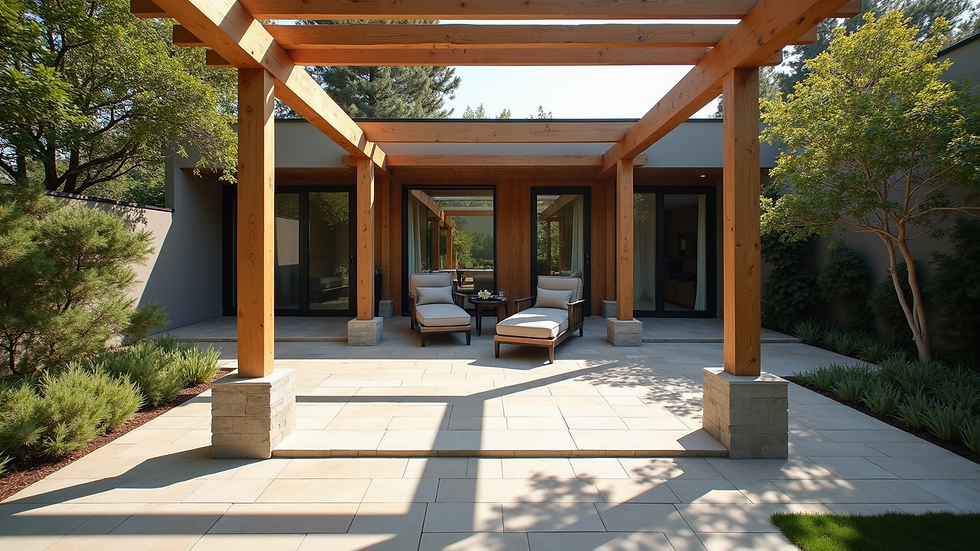Transform Your Landscape with Masonry Retaining Walls
- Allscapes Construction

- Sep 29
- 4 min read
Updated: Oct 7
Understanding Masonry Retaining Walls
A masonry retaining wall is built from materials like brick, stone, or concrete and is designed to support soil laterally. They are ideal for creating flat areas in sloped landscapes, allowing for the development of terraces, gardens, and other outdoor features. The strength of masonry materials means they can handle the pressure from the soil behind them, making them a solid choice for many landscaping projects.
Benefits of Masonry Retaining Walls
1. Erosion Control
One of the standout advantages of masonry retaining walls is their effectiveness at controlling erosion. In areas with steep slopes, heavy rains can wash away soil, causing significant damage. Installing a masonry retaining wall can prevent soil erosion, protecting not just your landscape but also your property. For instance, studies show that retaining walls can decrease soil erosion by up to 70% in heavily saturated conditions.
2. Aesthetic Appeal
Masonry retaining walls can transform the look of your property. With a wide range of materials available—like smooth concrete, rugged stone, or sleek brick—these walls can be customized to fit your preferred style. Whether you want a charming rustic vibe or a contemporary appearance, masonry retaining walls enhance the character of your yard. For example, a well-designed stone wall can become a stunning focal point, drawing attention and admiration.
3. Increased Usable Space
By leveling off a sloped yard, masonry retaining walls can significantly increase usable outdoor space. This means you can invest in new gardens, create patios, or even add outdoor kitchens. Imagine transforming a steep, unused section of your yard into a multi-tiered garden; this not only boosts functionality but also adds value to your home.
4. Improved Drainage
Proper drainage is essential for healthy gardens. Masonry retaining walls can incorporate drainage systems that redirect water away from the wall and prevent water buildup. By effectively managing water flow, these walls protect your plants and soil, reducing issues like soil erosion and waterlogging. In regions receiving over 30 inches of rain annually, proper drainage can be critical for maintaining landscape health.
5. Longevity and Durability
Masonry retaining walls are built to withstand time and weather. Unlike wooden walls that may rot or warp, masonry materials offer strength against the elements. With appropriate care, a well-constructed masonry wall can last for decades—often exceeding a lifespan of 50 years. This durability makes it an excellent long-term investment for homeowners.
Construction of Masonry Retaining Walls
1. Planning and Design
The first step in building a masonry retaining wall is careful planning. You’ll need to consider the wall’s height, length, and overall placement. Choosing the right materials is crucial, as well. Working with a landscape professional ensures that your plans conform to local building codes, making the project smoother and more compliant.
2. Excavation and Foundation
Next, the area must be excavated to create a solid foundation. Building a stable wall starts with background preparation, leveling, and compacting the ground. Depending on how tall the wall will be, adding a footer for extra support may be necessary.
3. Building the Wall
With a sturdy foundation in place, it’s time to construct the wall. This involves laying the chosen materials in a staggered pattern to maximize strength and stability. Incorporating drains during this step allows rainwater to be redirected away from the wall, safeguarding your landscape's integrity.
4. Finishing Touches
Once the wall is complete, adding finishing touches enhances its look. You might consider landscaping nearby, installing lighting, or adding decorative items like planters or seating areas. These features can turn a functional wall into an eye-catching element of your landscape.

Maintenance of Masonry Retaining Walls
Masonry retaining walls require regular maintenance for optimal longevity. Routinely inspect for damage, such as cracks or misalignment. Addressing problems early can save you costly repairs down the line.
Additionally, keeping the area clear of debris and plants ensures proper drainage. Cleaning your wall periodically prevents the buildup of moss or algae. These maintenance steps help keep your wall functional and visually appealing.
Enhancing Your Outdoor Living Experience
Masonry retaining walls bring numerous advantages to homeowners seeking to enhance their landscapes. From controlling erosion and adding beauty to expanding usable space and ensuring durability, these structures are indispensable. With careful planning, construction, and ongoing maintenance, a masonry retaining wall can elevate your outdoor area into a stunning and practical space for years to come.
Investing in a masonry retaining wall is not just a choice about function; it’s a way to enrich your outdoor environment. Whether you want to craft a captivating garden or manage a challenging slope, masonry retaining walls provide a perfect blend of practicality and attractiveness.
Final Thoughts
As you consider your outdoor living space, think about how a masonry retaining wall can transform your property. It’s not merely a structural addition; it’s an opportunity to create a beautiful, functional area that enhances your lifestyle. Embrace the possibilities and let your imagination guide you in designing the perfect outdoor retreat.
Remember, the right masonry retaining wall can make all the difference in achieving your dream landscape. So, take the leap and explore this remarkable feature for your home!






Comments